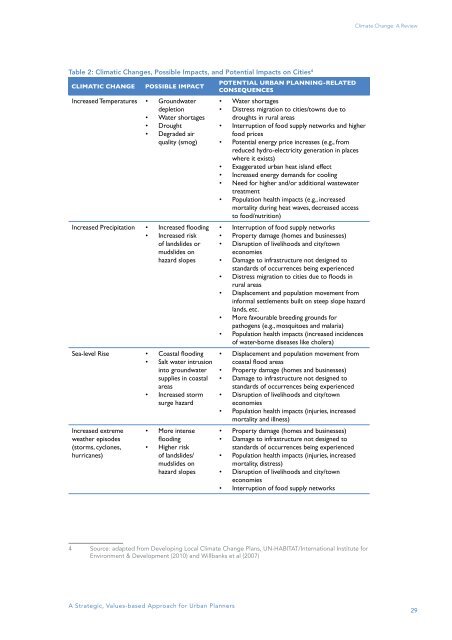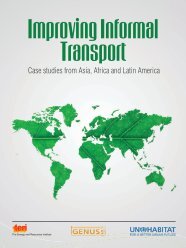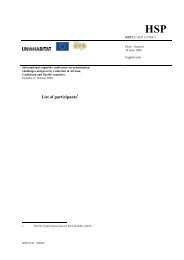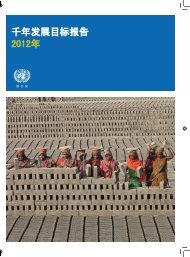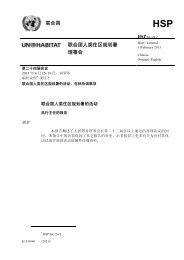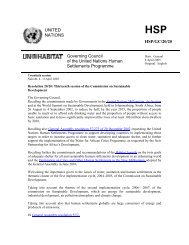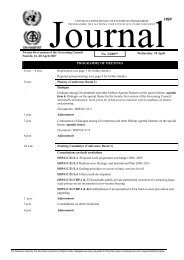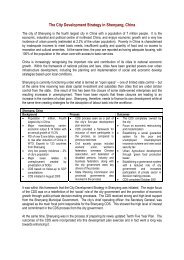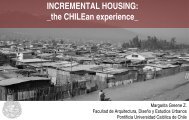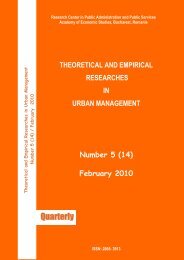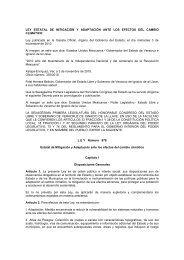Planning for Climate Change - UN-Habitat
Planning for Climate Change - UN-Habitat
Planning for Climate Change - UN-Habitat
You also want an ePaper? Increase the reach of your titles
YUMPU automatically turns print PDFs into web optimized ePapers that Google loves.
<strong>Climate</strong> <strong>Change</strong>: A Review<br />
Table 2: Climatic <strong>Change</strong>s, Possible Impacts, and Potential Impacts on Cities 4<br />
CLIMATIC CHANGE<br />
POSSIBLE IMPACT<br />
Increased Temperatures Groundwater<br />
depletion<br />
Water shortages<br />
Drought<br />
Degraded air<br />
quality (smog)<br />
Increased Precipitation <br />
Increased risk<br />
of landslides or<br />
mudslides on<br />
hazard slopes<br />
Sea-level Rise <br />
Salt water intrusion<br />
into groundwater<br />
supplies in coastal<br />
areas<br />
Increased storm<br />
surge hazard<br />
Increased extreme<br />
weather episodes<br />
(storms, cyclones,<br />
hurricanes)<br />
<br />
<br />
More intense<br />
<br />
Higher risk<br />
of landslides/<br />
mudslides on<br />
hazard slopes<br />
POTENTIAL URBAN PLANNING-RELATED<br />
CONSEQUENCES<br />
<br />
<br />
<br />
<br />
<br />
<br />
<br />
<br />
<br />
<br />
<br />
<br />
<br />
<br />
<br />
<br />
<br />
<br />
<br />
<br />
<br />
<br />
<br />
<br />
<br />
<br />
Water shortages<br />
Distress migration to cities/towns due to<br />
droughts in rural areas<br />
Interruption of food supply networks and higher<br />
food prices<br />
Potential energy price increases (e.g., from<br />
reduced hydro-electricity generation in places<br />
where it exists)<br />
Exaggerated urban heat island effect<br />
Increased energy demands <strong>for</strong> cooling<br />
Need <strong>for</strong> higher and/or additional wastewater<br />
treatment<br />
Population health impacts (e.g., increased<br />
mortality during heat waves, decreased access<br />
to food/nutrition)<br />
Interruption of food supply networks<br />
Property damage (homes and businesses)<br />
Disruption of livelihoods and city/town<br />
economies<br />
Damage to infrastructure not designed to<br />
standards of occurrences being experienced<br />
<br />
rural areas<br />
Displacement and population movement from<br />
in<strong>for</strong>mal settlements built on steep slope hazard<br />
lands, etc.<br />
More favourable breeding grounds <strong>for</strong><br />
pathogens (e.g., mosquitoes and malaria)<br />
Population health impacts (increased incidences<br />
of water-borne diseases like cholera)<br />
Displacement and population movement from<br />
<br />
Property damage (homes and businesses)<br />
Damage to infrastructure not designed to<br />
standards of occurrences being experienced<br />
Disruption of livelihoods and city/town<br />
economies<br />
Population health impacts (injuries, increased<br />
mortality and illness)<br />
Property damage (homes and businesses)<br />
Damage to infrastructure not designed to<br />
standards of occurrences being experienced<br />
Population health impacts (injuries, increased<br />
mortality, distress)<br />
Disruption of livelihoods and city/town<br />
economies<br />
Interruption of food supply networks<br />
4 Source: adapted from Developing Local <strong>Climate</strong> <strong>Change</strong> Plans, <strong>UN</strong>-HABITAT/International Institute <strong>for</strong><br />
Environment & Development (2010) and Willbanks et al (2007)<br />
A Strategic, Values-based Approach <strong>for</strong> Urban Planners<br />
29


